We test the new Scott Scale RC SL 2023: a new generation racing bike
The Scott Scale 2023 has just been presented and we've already tested it. This model arrives with the intention of winning back the hearts of those users who love pure cross country, at a time when the markets are enthusiastic about E-MTBs and full suspension bikes.
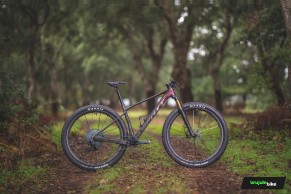
We test the new SCOTT Scale 2023
The lightest model of the Swiss brand has arrived full of changes, but maintaining its essence of fast and superlight bike. For a few weeks before its launch we have had the chance to ride it, to bring you first-hand all the sensations that this authentic competition machine has given us.
Conquers with a single glance
The unit that arrived to our editorial office was the incredible Scott Scale RC SL. The top of the range model. A bike made with the best carbon of the brand, the HMX-SL, combined with the most exclusive components to make real the hardtail that every racing fan would like to have.
RECOMENDADO

The best apps for cycling and mountain biking

Black Friday 2025 cycling bargains: save on Garmin, POC, Maxxis and more

Black Friday Garmin 2025: the ultimate guide to choosing your GPS at the best price

Which profile wheels to choose according to the area where you live: mountain, flat or coast

How to wash your cycling clothes? 10 keys to make them always look new

Cycling can help you fight the effects of the time switch
As we said at the beginning, it has undergone changes with respect to its previous version, some of which are easy to see with the naked eye and others which, although we cannot see them, do transmit driving sensations.
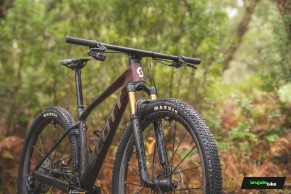
Right out of the box, the differentiation between strong areas and slender parts is noticeable. Combined with the Syncros Silverton SL wheels and the bulky 2.4" tyres, it gave the impression that this was not a very light bike. But nothing could be further from the truth, we were looking at a bike weighing only 8.9 kg.
Stiffness and lightweight are its trademarks
This lightweight is reflected in any situation that we have been facing in our testing days. Any uphill, no matter how hard it was, you could feel that light weight helping you to climb, motivated also by the fact that every pedal stroke we made catapulted us forward.
If any rider were given a choice of two characteristics of their frame, we are sure that the vast majority would opt for low weight and high stiffness. These two characteristics are difficult to obtain in equal proportion, since in order to achieve low weight it is necessary to remove material and that, in most cases, means reducing stiffness. However, at Scott they have managed to make more than 1 million combinations, through software, of the number of carbon layers, the arrangement of the fibres, the size of the patches... until they find the ideal one. Proof of this is that in any acceleration we made we could feel how the response of the bike was immediate. All our power was transmitted to the wheels without leaving a single watt on the road.
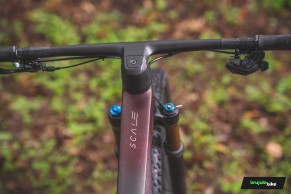
But not only these two virtues have been achieved. By dividing the frame into two zones and using a monocoque construction, it has been possible to give the upper zone less stiffness in order to filter out as many of the vibrations transmitted by the terrain as possible. Here, to a large extent, it is the 2.4" tyres that are responsible for the increased comfort. Although at first glance they may seem like a drag, they suit it well in terms of comfort and performance. The Syncros Silverton SL tyres may not be the best choice for absorbing bumps, but their wide inner width allows us to lower the tyre pressures to ridiculously low figures, gaining traction and giving us extra comfort on the roughest terrain.
Optimised geometry
We are used to hearing that geometry is what gives a bike its character and in this case by playing with the numbers we have achieved a balance between performance and comfort. From the beginning it was clear to us that we were at the controls of a racing bike. Even so, as the days went by, we noticed that the position on the bike was more optimised than we could have expected.
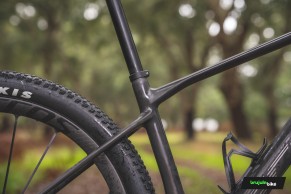
The reach has increased, but is countered by a more upright seat tube at 77.4° and a virtual stem of only 60mm. This makes our position quite racing, but without overloading the muscles in our hands and forearms.
This position above the bottom bracket allows us to achieve an efficient pedalling.
It's not just the pedalling that has been optimised. Steeper downhills are now a little easier to negotiate thanks to the head angle being relaxed to 67.9°. In addition, the same head angle adjustment mechanism has been implemented as on its full-suspension models, whereby the head angle can be adjusted by 0.6° by turning the upper part of the headset by half a turn.
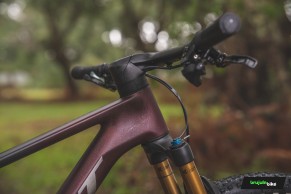
Generally speaking, a more aggressive steering system translates into a more sluggish performance in rough terrain, although in this case the lightness and reactivity of the rear end compensates for the lesser agility of the front end. It's easy to get it in the right place, and we could quickly correct any steering errors with a simple turn of the handlebars.
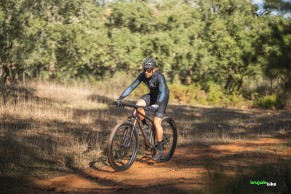
Integration as a differentiating element
Aesthetics is one of the qualities you like to find in a high-end bike. In the case of the Scale RC SL, integration plays an important role in making it as clean as possible.
At the front there are only three cables, which are routed under the 740mm wide Syncros Fraser IC SL handlebars to disappear from sight. We found this to be a sufficient size to maintain control and make it easier to change direction - hardtail cockpits are already less cluttered due to the absence of cables, but in this case, having the cables routed under the handlebars and passing into the frame through the headset results in one of the most integrated aesthetics on the market.
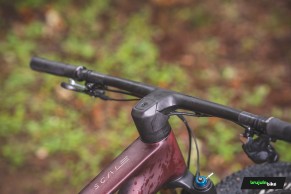
The rear axle is embedded in the junction of the seat stay and chainstay and goes unnoticed. Even the bottle cage mountings have covers to conceal them when not in use.
Exclusive, top-level set-up
In terms of components, Scott equips the Scale RC SL with some of the most exclusive on the market, such as the Syncros Silverton SL wheels or the Trickstuff Piccola brakes that are the object of desire of many. But that's not all, the rest of the components are also designed for maximum performance.
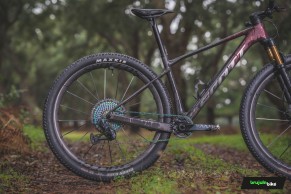
The drivetrain is the Sram Eagle XX1 AXS which also includes the Quarq power meter, an important detail for those users who compete or simply like to control their performance. We still haven't seen any trace of the new rear derailleur and cassette that we saw at the Les Gets World Cup, but there are few, if any, complaints about this drivetrain. Perhaps, if we were to make demands, we would prefer a different gear ratio. The 32 tooth chainring with the 10-52 cassette offers a very versatile combination, but it may be too small for the fittest bikers or those who are going to use this bike for competition, in fact, the 32-52T combination was not used in our tests. The low weight of the bike and its reactivity allowed us to climb all the slopes without using this ratio.
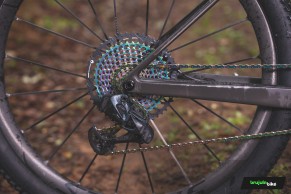
For the fork the Fox Factory 32 SC with 100 mm of travel has been chosen, which has shown impeccable performance, with three positions, lockout, intermediate and open, which are controlled from the RideLoc remote control. Here we are left with the question of how the Fox with 34 mm bars would suit it.
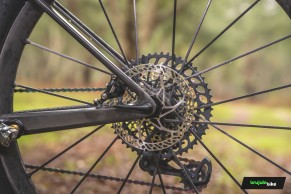
The Trickstuff Piccola C22 brakes are simply out of this world. They have a direct feel, allowing us to regulate the braking power easily, even locking if we need to without having to use much force. Weighing just 300 grams per pair, they help to keep the Scale's weight down. The 180 mm front disc is used, which has led us to believe that it has been taken into account to avoid overheating of the brakes on long descents, for those users who give it a more marathon use.
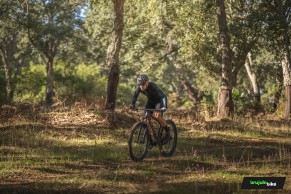
Syncros components complete the set-up
There's little we can say about the Syncros Silverton SL wheels that hasn't already been said. The 30mm inner width option suits them perfectly. Combined with the 2.4" Maxxis Rekon Race tyres, they make these stiff rims a little more comfortable. Although it is true that the first few hours we struggled to find the right pressure to achieve the right balance between comfort and impact protection. These wheels have been completed with another of the components that are surprising to find on this bike, we are talking about the Quarq TyreWiz pressure sensors. They add just a few grams to the Scale's precious weight, but in a racing machine like this you can get a lot of juice out of this gadget. We said at the beginning that we struggled to find the right pressure, but this invention made it easier to find that setting and also to maintain it on every ride thanks to how quick and easy it is to check the pressures with it. In the same way, users who use the Scale for XCO races will have in it an ally when it comes to getting the best setting for the circuits.
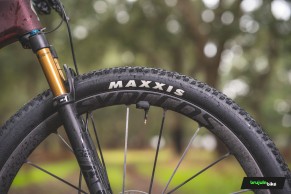
The set-up is completed with the Syncros Duncan SL carbon seatpost and the Syncros Belcarra saddle with carbon reinforced nylon base and carbon rails.
Not to be overlooked is the minimalist, lightweight and well-integrated chain guide and the removable rear axle lock with its characteristic multi-tool with Allen and Torx key.
Conclusions
The Scott Scale RC SL is designed to offer the user maximum performance. Thanks to its lightweight and stiffness, you will be able to push it in all situations and expect the best response. It comes equipped with all the details so that you can compete with it at the highest level right out of the box.
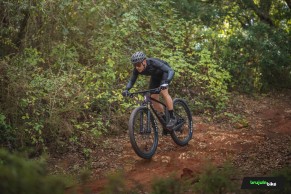
The agility it transmits will allow you to guide it along the routes, both uphill and on the most technical descents. It obviously doesn't offer the comfort of a full suspension, but bikers who opt for this segment know what they're going to find.
It has a geometry optimised to the moment, with dimensions that help to transmit a good feeling without sacrificing too much of the biker's position on it.
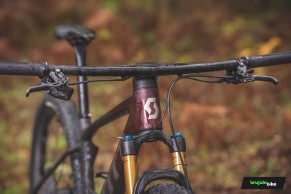
It is not suitable for all budgets, but it is the price to pay for maximum performance and the highest level of finish.